The Daily Telegraph by Rowdy Wylie
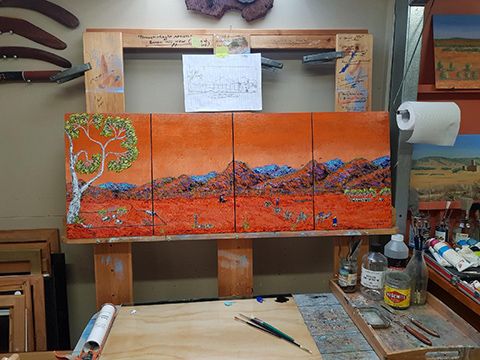
Before Jane and I say goodbye to Outback Australia for the time being I thought you would all enjoy seeing one of Rowdy Wylie's latest paintings which illustrates his great love of the Australian outback and of the historical narrative that literally weaves its way across this vast landscape - the building of The Daily Telegraph.
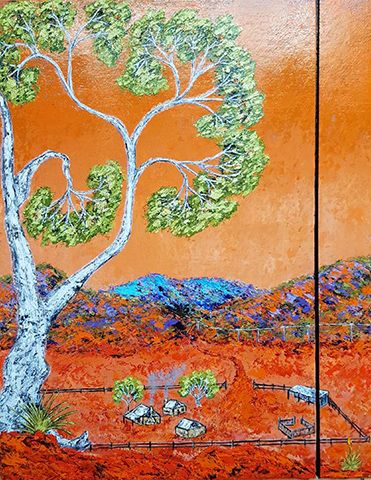
The Daily Telegraph by Rowdy Wylie represents the building of the outback telegraph in Australia which was completed in 1872. This connected Down Under to the rest of the world: a message sent from the remote town of Alice Springs (in the Northern Territory) to London would take only 5 hours. A miracle at this time.
Rowdy's painting depicts scenes from the building of the telegraph line and was created using oil paints on Hard Board in a quadriptych Format. The size of the painting being: H45cm x W120cm.
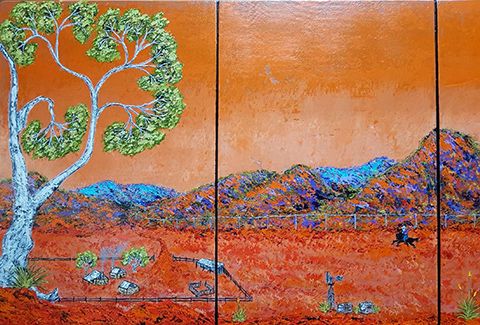
The Australian Overland Telegraph Line was a 3,200 km (2,000 mi) telegraph line that connected Darwin with Port Augusta in South Australia. Completed in 1872, the Overland Telegraph Line allowed fast communication between Australia and the rest of the world. An additional section was added in 1877 with the completion of the Western Australian section of the line. It was one of the great engineering feats of 19th-century Australia and probably the most significant milestone in the history of telegraphy in Australia.1
This amazing achievement by Australia’s early pioneers was secured in 1870 when the South Australian government agreed to construct 3200 km of line to Darwin, while the British-Australian Telegraph Company promised to lay the undersea cable from Banyuwangi, Java to Darwin. The latter was to be finished on 31 December 1871.1
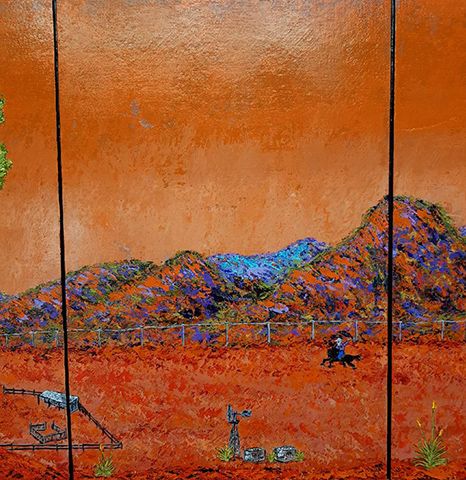
The full story of the construction of the telegraph line can be read by following the bookmark link given at the end of the post.
But significant facts include:
The Overland Telegraph changed the way Australia related to the world and the country’s extreme isolation was broken.2
The line featured 36,000 telegraph poles and 11 repeater stations (necessary to boost the strength of the electrical signal), each about 200 kilometres apart. The Overland Telegraph cost £239,588, almost double the original budget.2
The telegraph line also opened up the centre of the continent. Within a year of its construction gold was being mined around Pine Creek (near Katherine) and within 10 years the cattle industry had been established in the Northern Territory.2
Prospectors and graziers used the repeater stations as centres from which to explore and stake claims on the land. Alice Springs, which was established as a repeater station, became the administrative hub for central Australia.2
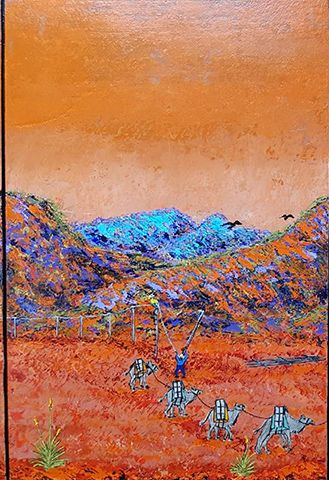
The rich texture of the outback country is captured so brilliantly by Rowdy's palette knife reminding the viewer of the great array of colours and tonal changes in this landscape.
The role of the Afghan cameleers in Australia is also graphically represented in the painting as their role in developing Australia was significant.
These camel drivers worked in Outback Australia from the 1860s to the 1930s. Small groups of cameleers were shipped in and out of Australia at three-year intervals, to service the Australian inland pastoral industry by carting goods and transporting wool bales by camel trains. They were commonly referred to as "Afghans", even though a lot of them originated from the far western parts of British India, primarily Balochistan (part of Pakistan, Iran and Afghanistan) and the NWFP (A province of British India), which was inhabited by ethnic Afghans and Balochs, nonetheless many were from Afghanistan itself as well, in addition to that there were also some with origins in Egypt and Turkey.1
The majority of cameleers, including Indian cameleers, were Muslim, while a sizeable minority were Sikhs from the Punjab region. They set up camel-breeding stations and rest-house outposts, known as caravanserai, throughout inland Australia, creating a permanent link between the coastal cities and the remote cattle and sheep grazing stations until about the 1930s, when they were largely replaced by the automobile...They provided vital support to exploration, communications and settlement in the arid interior of the country where the climate was too harsh for horses. They also played a major role in establishing Islam in Australia, building the country's first mosque at Marree in South Australia in 1861, the Central Adelaide Mosque (the first permanent mosque in Adelaide, still in use today), and several mosques in Western Australia.1
Many of the cameleers and their families later returned to their homelands, but many remained and turned to other trades and ways of making a living. Today, many people can trace their ancestry back to the early cameleers, many of whom intermarried with local Aboriginal women and European women in outback Australia. 1
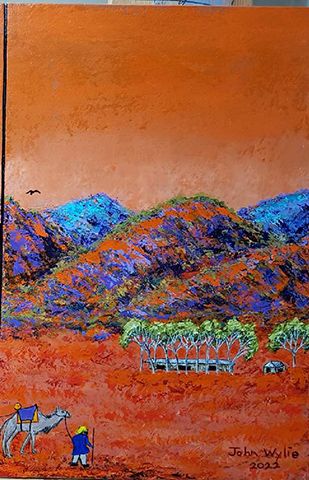
Connecting Australia to the rest of the world enabled Australia to be part of the sophisicated communication system of telegraph messages (telegrams) which were being transmitted during the late 1800s in enormous numbers even though at great cost. Australia was no longer a remote penal come early settler colony - we became part of the international scene and contributed greatly in many ways to the Boer War and later WWI and WWII - thanks to the telegram in conjunction with radio transmitted messsages which had also been invented in the late 1800s.
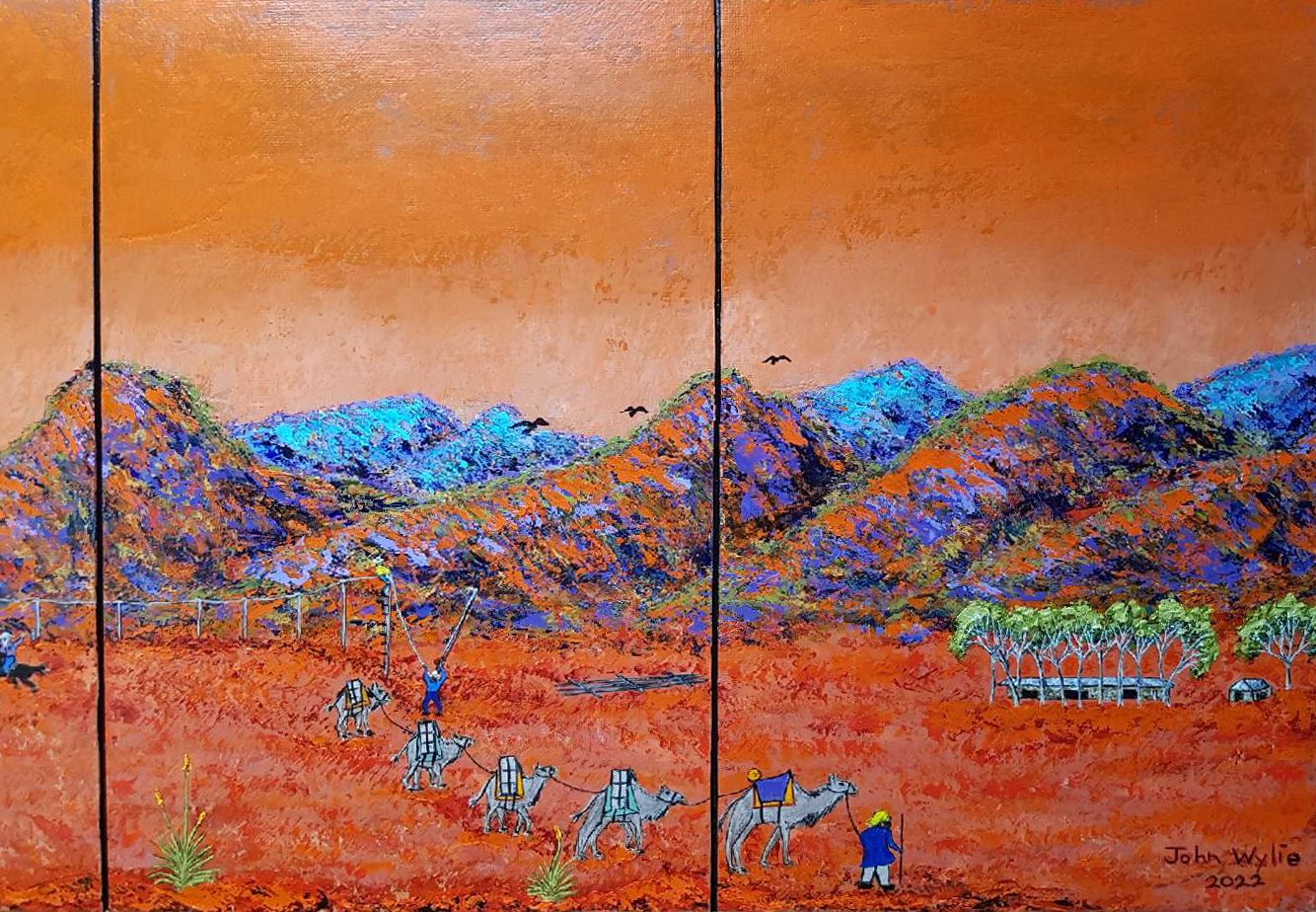
Thank you Rowdy - your paintings not only tell us so much about country and landscape but historically significant narratives. To learn more about the Australian Overland Telegraph Line follow the bookmark link below.

And tomorrow - a reminder that there was another remarkable invention which had started to open up countries around the world - in some cases as with Great Britain in the 1820s and even in Australia more than 20 years before the telegraph - train lines were being built within the developing cities of Melbourne and Sydney. The construction of the rail line to link Darwin to the rest of Australia commenced in 1878 only 6 years after the telegraph was opened but took until 1929 to complete.
Recently Julie went for a ride on a restored Red Rattler and tomorrow she is going to share the experience with you!
Credit
1. en.wikipedia.org
2. nma.gov.au


